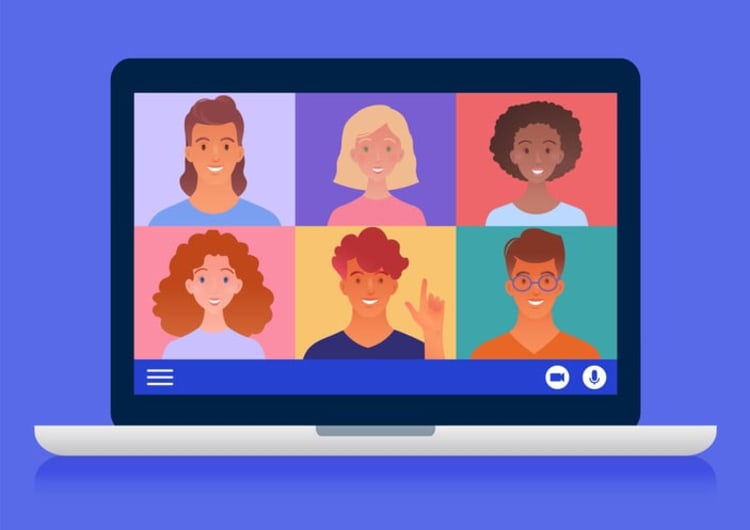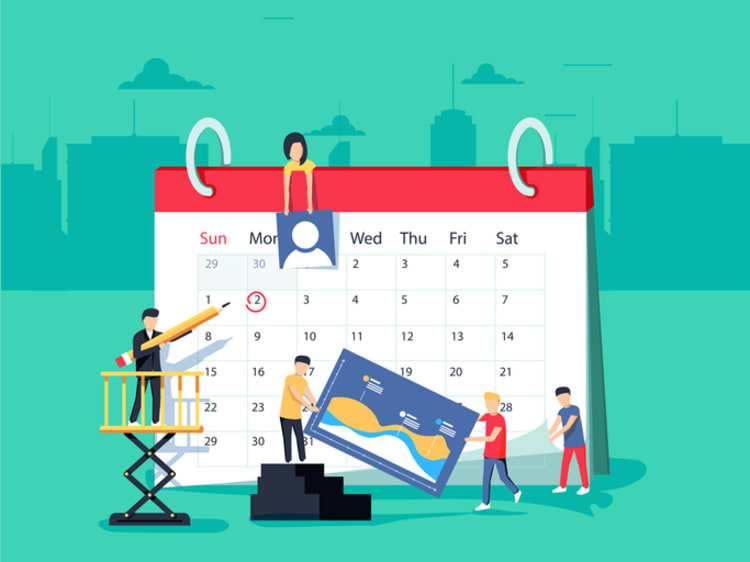In today’s fast-evolving digital landscape, virtual events have emerged as a powerful way to connect, educate, and entertain audiences across the globe. But how can you ensure your virtual event stands out in a sea of online gatherings and leaves a lasting impression on your attendees? The answer lies in strategic planning, cutting-edge technology, and a relentless focus on engagement. Dive into this ultimate guide to hosting a successful virtual event and unlock the secrets to creating unforgettable online experiences.
Key takeaways
- Understand the different types and formats of virtual events to remain competitive.
- Carefully plan objectives, audience, platform, format & team for successful execution.
- Leverage event technology to create immersive experiences & gather data for future optimization.
Understanding virtual events

Virtual events are online gatherings that utilize web-based platforms to replicate in-person experiences, offering various formats such as webinars, live streams, and hybrid events. These events have become a popular choice among event organizers, thanks to their time efficiency and cost-effectiveness. With a myriad of virtual event ideas available, including virtual conferences, virtual social events, and even unique experiences like virtual museum tours and escape rooms, there is no limit to the creativity and innovation possible in the virtual events industry.
Staying ahead in the game requires a deep understanding of the various types of virtual events and their evolution, especially as the demand for online events accelerates.
Types of virtual events
From webinars to virtual conferences, there is a diverse range of virtual events available to cater to specific needs and objectives. Some examples include:
- Internal and external hybrid events
- Virtual exhibitions
- Seminars
- Trade shows
These are just a few examples of the many options at your disposal.
Selecting the appropriate type of virtual event can lead to effective audience engagement, valuable content delivery, and the achievement of your desired outcomes.
Evolution of virtual events
The evolution of virtual events can be traced back to the mid-1990s, with significant growth driven by technological advancements, economic factors, and global crises. The late-2000s recession, for instance, saw a surge in virtual event popularity due to their cost-effectiveness and environmental sustainability compared to traditional in-person events.
As technology continues to advance, the events industry is constantly adapting and innovating to meet the ever-growing demand for virtual events and enhance the overall experience for both virtual event organizers and attendees.
Planning your virtual event

Meticulous planning and attention to detail are the cornerstones of a well-executed virtual event. This involves setting clear objectives, selecting an appropriate platform, and assembling a dedicated team. By understanding your target audience and selecting the most suitable event format, you set the stage for a successful virtual event that meets the expectations of both organizers and attendees.
Remember, a well-planned event is the foundation for a memorable and engaging experience.
Setting clear objectives
To ensure alignment with your goals and to provide value to the attendees, it is essential to establish clear objectives for your virtual event. Start by identifying the desired outcomes from a business perspective, such as increasing brand awareness, generating revenue, or expanding memberships.
Next, consider what your attendees expect from the event, such as networking opportunities, educational content, or entertainment. Understanding and addressing these objectives sets the stage for a virtual event that delivers on its promise.
Choosing the right platform
To deliver a seamless and engaging virtual event experience, selecting the right platform is of paramount importance. Kumospace is an excellent choice for hosting your next virtual event as it offers:
- Comprehensive resources and expert guidance for planning a successful virtual event
- Features like video chat, screen share, spatial audio, and security
- Smooth communication and interaction between presenters and attendees
By selecting a platform that meets your needs and supports your event’s objectives, you can create an online experience that leaves a lasting impression on your audience.
Assembling your team
Executing a successful virtual event requires a dedicated team of professionals with diverse skill sets. Assign roles and responsibilities based on the objectives of the event, such as:
- Event coordinator
- Technical support
- Content creator
- Moderator
Equip your team with the necessary resources, training, and support to ensure they are ready to tackle any challenges that may arise during the event.
A well-prepared and cohesive team is the backbone of a memorable virtual event.
Enhancing attendee engagement

One of the key challenges in hosting a virtual event is maintaining attendee engagement. To create a successful virtual event, you should prioritize the following:
- Interactive features: Incorporate polls, Q&A sessions, and live chats to encourage active participation from attendees.
- Networking opportunities: Provide virtual networking sessions or breakout rooms where attendees can connect and build relationships.
- Gamification elements: Introduce games, challenges, or competitions to make the event more interactive and enjoyable. By focusing on these aspects, you can create a virtual environment that fosters a sense of community and encourages participation, ensuring a memorable experience for all attendees.
Interactive features
Interactive features such as live Q&A, polls, and chat functions are essential tools for keeping attendees engaged and encouraging participation in virtual events. By allowing attendees to actively contribute to the event and interact with presenters and fellow attendees, you create a dynamic and immersive virtual experience that rivals the engagement of physical events.
Leverage these interactive elements to break down the barriers between presenters and attendees and create a more meaningful and enjoyable virtual event.
Networking opportunities
Networking opportunities, such as breakout rooms and virtual meet-ups, can facilitate connections and foster community among attendees. Encourage attendee networking by providing dedicated networking time, using registration data to connect like-minded individuals, and facilitating conversation through video calls and chat groups. Utilizing effective networking tools can further enhance these connections.
By creating an environment that encourages networking, you empower attendees to build relationships, exchange ideas, and make the most of their virtual event experience.
Gamification

Gamification, including scavenger hunts, leaderboards, and trivia, can significantly increase audience engagement and improve the overall event experience. By introducing fun and interactive elements, you can keep attendees entertained and motivated throughout the event, resulting in higher satisfaction and a more memorable experience.
Don’t be afraid to think outside the box and incorporate unique gamification elements that resonate with your audience and event theme.
Promoting and marketing your virtual event

To drive attendance, generate buzz, and ensure the success of your virtual event, effective promotion and marketing strategies are necessary. By implementing a multi-faceted marketing strategy that includes pre-event promotion, during-event promotion, and post-event follow-up, you can create excitement around your event and attract a wider audience. Remember, a well-promoted event is more likely to be a successful one.
Pre-event promotion
Pre-event promotion is the first step in generating buzz and driving registrations for your virtual event. Create a comprehensive marketing plan that includes a compelling event website, email marketing, social media promotion, and partnerships with influencers or sponsors.
By leveraging these promotional channels, you can reach a wider audience, build anticipation for your event, and ultimately drive higher attendance.
During-event promotion
During-event promotion is crucial for maintaining momentum and keeping attendees engaged throughout the event. Utilize live social media updates, real-time engagement, and encourage attendees to share their experiences on their social channels.
By actively promoting your event while it’s happening, you can create a sense of excitement among potential attendees, driving last-minute registrations and further expanding your reach.
Post-event follow-up
Post-event follow-up is essential for capitalizing on the momentum generated during your virtual event and ensuring a lasting impact. Send thank you emails to attendees, share event highlights on social media, and analyze data to optimize future events.
By maintaining communication with attendees after the event, you can continue to foster connections, gather valuable feedback, and set the stage for even more successful events in the future.
Leveraging event technology

Enhancing the live event experience in a virtual setting and providing valuable insights to organizers necessitates the embracing of event technology. By leveraging live streaming platforms, virtual booths, and analytics tools, you can create immersive and interactive experiences for attendees while also gathering data to improve your future events.
As technology advances, it’s essential to stay up-to-date with the latest tools and trends to ensure your virtual events remain relevant, engaging, and successful.
Live streaming and video conferencing platforms
Any successful virtual event hinges on real-time communication and interaction between presenters and attendees. Virtual conferencing tools, such as live streaming and video conferencing platforms like Kumospace, enable this level of interaction while also providing a range of features and tools to enhance the overall event experience.
By selecting the right platform for your virtual event, you can ensure smooth, high-quality communication and create an engaging and immersive experience for all attendees.
Virtual booths and exhibitions
Virtual booths and exhibitions provide opportunities for exhibitors to showcase their products and services, while attendees can explore and engage with the content on offer. These virtual spaces allow for increased brand recognition, comprehensive analytics of attendee engagement, and extended exposure for sponsors and exhibitors.
By incorporating virtual booths and exhibitions into your event, you can create a dynamic and interactive environment that mimics the experience of attending a physical trade show.
Analytics and reporting
Tracking engagement, measuring success, and gathering insights for future event improvements demand the use of analytics and reporting tools. By utilizing these tools, event organizers can better understand their audience, identify trends and patterns, and make data-driven decisions to optimize their virtual events.
By leveraging analytics and reporting tools, you can continually refine your event strategy and ensure that each virtual event you host is more successful than the last.
Real-life virtual event success stories

Real-life virtual event success stories demonstrate the potential of virtual events to reach global audiences, generate revenue, and create memorable experiences. From small-scale webinars to large virtual conferences, these success stories showcase the power of careful planning, innovative technology, and a relentless focus on attendee engagement.
By learning from these examples, event organizers can continue to push the boundaries of what’s possible in the virtual event space and create their own success stories.
Overcoming challenges and pitfalls

Success in hosting a virtual event comes with its fair share of challenges and pitfalls. From technical issues to maintaining attendee engagement, event organizers must be prepared to face and overcome these obstacles. By carefully planning your event, remaining flexible and adaptable, and prioritizing attendee engagement, you can ensure a successful and enjoyable experience for all involved.
As the world of virtual events continues to evolve, learn from past experiences and embrace new opportunities to create unforgettable online gatherings.
Summary
In conclusion, hosting a successful virtual event requires a strategic approach, a focus on attendee engagement, and the effective use of technology. By understanding the various types of virtual events, planning carefully, promoting and marketing your event, and leveraging event technology, you can create a memorable and engaging experience for all attendees. As the world of virtual events continues to evolve, stay ahead of the curve by embracing new tools, trends, and best practices to ensure your virtual events are always a resounding success.
Frequently asked questions
A virtual event is an online gathering of people that takes place over the web, rather than in a physical location. This type of event provides attendees with a unique way to interact, participate, and engage with others.
Virtual events come in many different formats, such as networking, webinars, conferences, trade shows, job fairs, training sessions, and town halls. All of these formats allow for online interaction and engagement from participants.
To successfully run a virtual event, you should know your target audience, set clear goals, choose an appealing topic and the right platform, promote the event, create an agenda with speakers and timeframes, including moderators, engage the audience, prepare to troubleshoot and use best practices for networking features, webinars, evergreen content, and post-event analytics.
Virtual events can be engaging and interesting for everyone involved. Examples of virtual events include video calls, webinars, online seminars, live-streamed classes, virtual networking, online meetups, and online conferences. Make your virtual event engaging by using exciting content and interactive features such as polls, surveys, and breakout rooms.
Keep attendees engaged during a virtual event by utilizing interactive features such as live Q&A, polls, chat functions, networking opportunities, and gamification elements.






